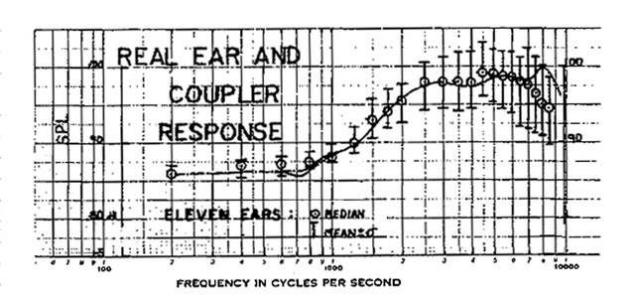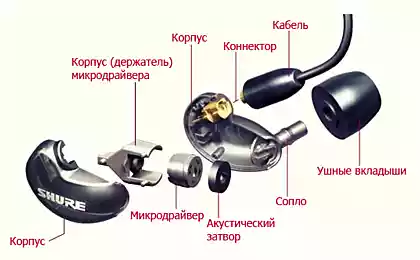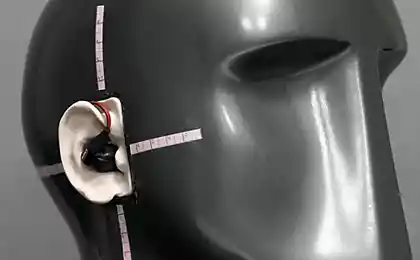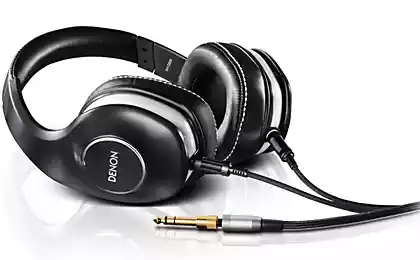5 reasons why people value different headphones sound different

Of all types of audio devices, with whom I was dealing with difficulties arise only with headphones. Many of panel tests that I conducted for Sound & Vision, and those that I spend now for The Wirecutter, makes a huge difference in the perception of sound headphone certain kinds of people. After reading the reviews and comments, you can see that different opinions more than it seems. Even excluding the views of "trolley" is still evident that different people hear different sounds.
There are several reasons. I described one of them a few months ago in an article "Why the headphones sound different to different people. Part 1 ". I promised that I would write a part 2, and so I did it. Part 1 was lost in the ongoing reconstruction of the site About.com, so I give it below as part of this article.
You can not have a pair of identical ears h4> Reason 1: Hearing channels differ
Soendergard Jacob (Jacob Soendergaard), Sales Agent GRAS Sound and Vibration (the company that produces tools for testing my headphones), told me about this phenomenon, and was kind enough to show me a very interesting PDF-файл, describes the process of developing modern hearing simulators and simulations of the head and torso.
Very wise and witty words of scientist SK Dalsgard (SC Dalsgaard) from Odense University pertaining to the above projects - he said: "We model the perception of a person with a very large error ».
Soendergard said:
«Every minute change in the geometry of the ear canal (the shape of the ear canal, the number of folds in the channel, the ratio of its sides, the location of the double bends, the size of the tympanic membrane, etc.) affects the auditory perception - especially in the perception of high frequency very short wavelengths ». blockquote>

You can see it on the graph above, which is a simplified version of the circuit shown in said home PDF-file. On the chart compares the readings obtained inside the ear canals 11 subjects with readings device designed to test hearing aids. For each test frequency can be observed frequency response device (solid line), the average values of sound pressure at 11 test objects (circle) and the amplitude of the action (a thing that looks like on its side wide letter H).
As you can see, the sound pressure on the ear canals at frequencies below 1 kHz is not much change as compared with the device at frequencies above 2 kHz, the difference becomes larger, and at frequencies above 10 kHz, the difference is huge and is + \ - 4 dB. Objectively say that the difference of + \ - 2 dB, say while reducing bass 2 dB and raising the level of high frequency 2 dB, enough to affect the tonal balance of the headphones.
Soendergard and I analyzed the data of measurements - we had to conclude that rumor at all different, because our eardrum - a measuring instrument, the principle of which is similar to the microphone in the ear simulator. As said Soendergard if displace human eardrum even by a millimeter, the study at frequencies from 10 kHz to 20 (the threshold of human hearing) will give quite different results.
Thus, differences in the shape of the ear canal, as well as the fact that the headphones are people with different forms of the ears and ear canals may affect the perception of high-frequency sound. The difference is only 1mm can affect the quiet sound of the headphones and make him or too severe or too muted.
I have experienced this first hand a few years ago, when the composer (whose name will remain anonymous) told me that he really likes some In-ear monitor. These were the headphones that sounded incredibly dull, and most obzorschikov agreed. Measurements that I spent confirmed deviation of 3 kHz. I worked with this person in the past, and we both came to the same conclusions regarding overhead and full-size headphones, but his conclusions on the In-ear monitor radically different from mine (later audiologist said that the shape of the ear canal it was very unusual).
The feeling of space all different, at least in the headphones h4> The reason №2: The transfer function in the brain all work differently
Your brain uses transfer function head for determining the sound in three dimensions. The function takes into account the differences in the time in which the sound reaches each ear, the differences in volume for each ear, and the differences in frequency response caused by the acoustic effect of your head, shoulders and ears when the sound is coming from different directions. Your brain processes and interprets these signals to let you know, where is the source of the sound.
Using headphones eliminates the influence of the acoustic effects of the body and changes the time of arrival of the signal and its volume compared with listening to music through the speaker system or "live" concert. Unfortunately, your brain can not simply turn off the transfer function. When you put on the headphones, your brain continues to try to determine the source of the sound, and can not do it correctly, the result is a feeling that the sound source is located right in the head.
I understand that everyone has their own unique transfer function of the head, visit the company's Virtual Listening Systems in early 1997. To create a processor for headphones, which later became known as Sennheiser Lucas , VLS studied the properties of sound perception of hundreds of people. To do this, they put tiny microphones in their ear canals and put in soundproofed rooms . Small speaker on the robotic arm to reproduce М-последовательность sounds. The robot moved the speaker in one of the 100 different positions at different angles, each time uttering a series of signals, so that the microphones in the ears test could "hear" as the body and ears affect the perception of sound.
(Fans of headphones can be noted that this procedure is similar to way of measuring , which was used Smyth Research, and used to create the CPU A8 Realiser )
I went VLS-test yourself. Scientists of my results downloaded to a processor which modifies the audio signal and making it identical to the transfer function of the head. The result was stunning, I have not heard that at least one audio processor used headphones to reproduce something similar. I've heard the exact, perfect centralized picture, like a singer, was right in front of me - such an effect on me is even headphones from Dolby.
VLS filmed testimony from hundreds of people and created a processor Lucas 16 different presets, each of which simulates the transfer function. Going through each one in turn, it is difficult to stop on any one. I remember that some of the settings were clearly better than everyone else, but it was hard to choose one among the top four or five. But none of them gave the same result, as chosen individually for me in the laboratory VLS.
Probably for this reason, most processors for headphones have far fewer options, and they are working on some averaged transfer function. Maybe you're lucky and your transfer function will be close to this approximation. Or not, then the sound will seem too saturated, and may be too weak.
Because each has its own transfer function of the head, so too, each have distinct from other curve compensation affects the sound - something like an equalizer. When compensation curve superimposed characteristics of your body, the result is the sound you hear on a daily basis. If you eliminate the influence of the parameters of the body through the use of headphones, then your brain will rely only on the compensation curve. And since each of these individual curves, the effect of the same headphones for different people different.
No insulation - no bass h4> The reason №3: Form headphones changes the sound
Good sound reproduction is largely dependent on the shape of the headphones. In particular on how the bow ears ear cups full-size headphones, as overhead headphones sitting on the pinna, or how conveniently In-ear monitor of silicone or foam in the ear. If a good noise isolation headphones, the entire bass that they are able to produce, will come to your ears. If somewhere there is a "loss of sound", the bass will be less pronounced, and you will notice how the tonal balance is shifted toward higher frequencies.
In part, the physical features of your body determine suitable for you headphones. For example, if none of replaceable tips In-ear monitor you do not have the right size, their sound does not seem like a good one. This can be a problem for me, because I have an unusually large size ear canals, and for my colleagues Jeff Morrison (Geoff Morrison), as he they are unusually small. For this reason, I always thank headphone manufacturers who invest in a box with headphones five or more different linings. So, if you are unhappy with the sound of their In-ear monitor, you may want to look at the lining foam from Comply.
Bad landing overhead and full-size headphones are also not uncommon. I would suggest that it is more so for the latter, because in order to achieve good sound insulation, it is necessary to take into account many factors. Among these factors can be identified long and / or thick hair, glasses, and even earrings. Subtract ear pads even a millimeter from the head and part of the bass disappears, which significantly affect the sound quality headphones.
Full-size and overhead headphones are suitable for some people better than others. Some headphones for audiophiles, such as Audeze LCD-XC are so large ear cups that can fully embrace ears and cheeks of the comparatively tiny people, especially women. At the same time, some supposedly full-size headphones are not even able to cover large earlobes like me.
It is worth noting that poor insulation can also have a positive effect. Slightly weakened insulation can make the sound headphones with powerful bass even more - we found out, creating review "Best In-ear monitor for $ 100" for The Wirecutter. Of those surveyed in the topic headphones my favorite - it Grain Audio IEHP , which for me makes an excellent smooth and natural sound. I decided that IEHP sound so good, because silicone pads provide good noise isolation. Although for all other bass at IEHP was too strong. Apparently, the overlay did not provide me proper sound insulation, but provide it to others, and it dramatically changed my attitude to the headphones for the better.
The reasons that do not depend on the headphones h4> The reason №4: Personal preference
Of course, there are reasons that apply not only to the headphones, on which people differ in their perception of sound.
The first reason, it is also the most obvious: different people - different musical taste. Some like it a bit more bass than you, or more treble. Obviously, you will choose different headphones.
Continuing the theme. Apart from the usual, normal tastes, some people have a mistaken, or, frankly, wrong opinion about the sound. We all met people who believe that good sound - is nothing more than a ridiculously loud bass. Some enthusiasts prefer strongly expressed high frequencies, which they mistakenly believe accuracy and detail. I myself have been through this, but priceless works Gordon Holt (J. Gordon Holt) guided me to the right path. < br />
Whatever made such listeners happy, it has a right to exist, but their opinions about the sound can be useful only for those who have a similar extreme tastes, and your choice of these people try to justify unprofessional and unfounded judgments.
Reason №5: Opportunities hearing vary with age, according to gender or lifestyle
While most of us is born with approximately the same hearing capabilities, they change throughout life.
The more you are exposed to loud sounds, the more likely a partial loss of sensitivity to high frequencies. This is especially a problem for people whose leisure (hiking to loud concerts, driving race cars, hunting, etc.) and / or work (construction, military, manufacturing, etc.) associated with loud sounds.
The older you get, the more likely to lose the perception of high frequencies. This is especially true for men. According to the article «Study of gender differences and age hearing loss" from журнала Acoustical Society of America: "... the majority of the frequency hearing sensitivity is reduced by more than two times faster in men than in women ..." partly because men are more likely than women taking jobs where they are exposed to loud noises, such as the one that was mentioned above . Also, studies showed , that men are much more receptive to loud noises, 6-10 dB above the level of the sound, comfortable for women.
Obviously, the characteristics of the audio perception will change in accordance with changes in hearing. For example, the high-order harmonic distortion that occurs at frequencies of 5 or more times the fundamental frequency of the sound is likely to be more trouble 25-year-old woman, 60-year old man, moreover, sound frequency 12kHz he can not even hear, but it will be unbearable for the 25-year-old woman.
What can we do about it?
The obvious question is: "How can I assess any headphones it to be informative and useful for any listener?»
Unfortunately nothing. But we can try.
In my opinion, the key is the taking of evidence from a variety of students with different forms of head and ear canals. It made Lauren Dragan (Lauren Dragan) in the review of headphones, organized for the The Wirecutter , and we did when I was in the Sound & Vision.
I would like to do it here in the About.com Stereos, but, unfortunately, do it financially unprofitable, given the small number of monitored my headphones, and how much I paid for it. So the best I can do - it provides links to my other reviews whenever possible. My articles for About.com Stereos and reviews of headphones for SoundStage! Xperience I complement laboratory measurements to give an objective view of what is the frequency response of the headphones.
"Gold standard" should take into account the opinion of a plurality of listeners and laboratory measurements. I did this when I was working on Sound & Vision, but at the moment I do not know of any publications that have worked on this.
From all this it follows one simple rule: Be careful before you make fun of other people's opinions about headphones.
Special thanks to Jacob Soendergardu of GRAS Sound and Vibration and Dennis Burger (Dennis Burger) for their help and comments on the article. Whether your preference is the same (relatively headphones) with the opinion of your friends / colleagues?
Yes, do not differ Not really, but trust one brand No too difficult to compare Do not talk about this topic, chosen by the Only registered users can vote in polls. Sign , please. 293 people voted. 66 people abstained.
Source: geektimes.ru/company/audiomania/blog/242162/
























